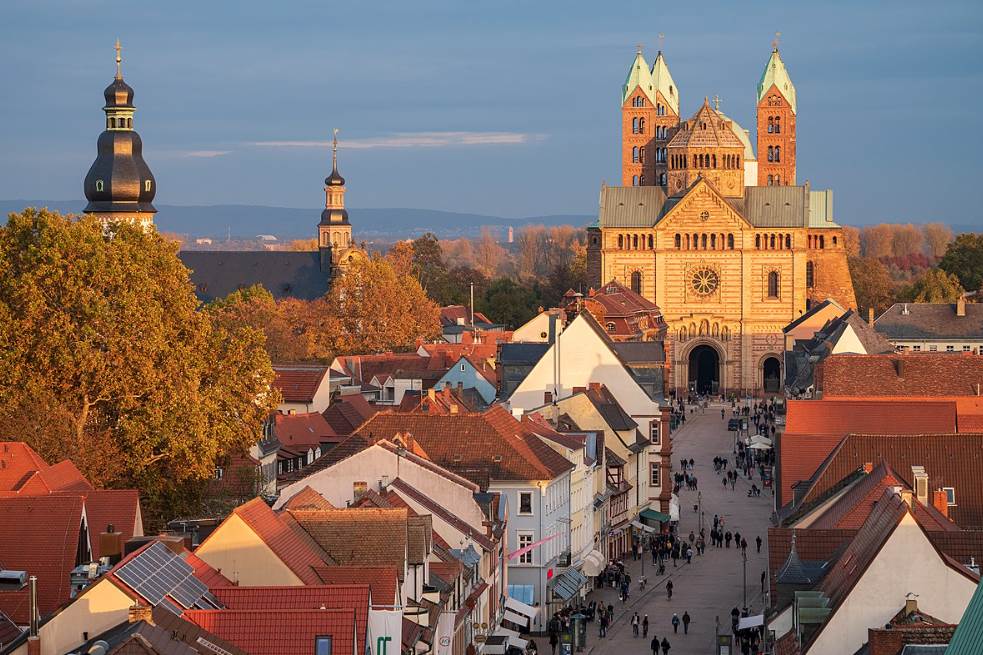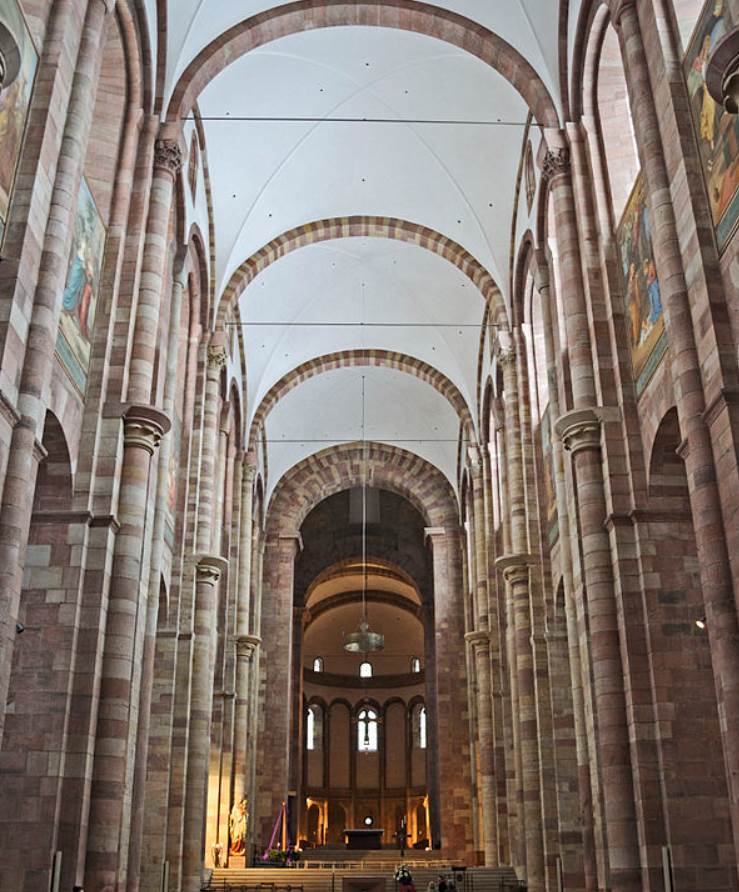If there’s one building that defines Romanesque architecture, then it’s most certainly this immense cathedral in Germany.
It has a history that dates back to the 11th century and it became the architectural model for churches built across Europe in the following centuries.
In this article, we take a closer look at some of the most interesting facts about Speyer Cathedral, a remarkable monument of the Romanesque era.
1. It’s located in the city of Speyer in southwest Germany
Speyer Cathedral is a monumental church located in the relatively small German city of Speyer. It’s situated in the German state of Rhineland-Palatinate in the southwest of the country.
The city was established on the left bank of the Rhine River, one of the main rivers in this part of Europe, and has approximately 50,000 inhabitants.
A park known as the “Domgarten Speyer” is squeezed in between this majestic red sandstone building and the river.
On the opposite side, the Maximilianstraße approaches the cathedral’s western façade and leads to the “Domplatz” or “Cathedral Square,” right in the heart of the city.

2. It was commissioned by the Holy Roman Emperor in the year 1025
Conrad II, also known as Conrad the Elder (989-1039), was the Holy Roman Emperor in the 11th century. Ambitious as he was, he wanted to build the largest and most amazing church in the Western World.
He conceived the plan in the year 1025 and the first stone of Speyer Cathedral was laid in 1030.
Conrad surely knew that he wouldn’t live to see this magnificent feat of architecture completed, so he also wanted it to serve as his final resting place.
The official name of the cathedral is the “Imperial Cathedral Basilica of the Assumption and St Stephen.” His son Henry III (1016-1056) continued the work but neither saw the building completed in 1061.

3. The Emperor’s grandson enlarged the cathedral in the early 12th century
Ambition ran in the family, that’s for sure. Conrad’s grandson, Holy Roman Emperor Henry IV (1050-1106), wasn’t satisfied with the completed Romanesque structure just yet.
The church had been consecrated in 1061 when it was just about completed and it was one of the main building projects in Europe at the time.
It was just as ambitious as Santiago de Compostela Cathedral (started in 1075), Cluny Abbey (Cluny III, started in 1085), and Durham Cathedral (started in 1093).
Regardless, he partially reconstructed the building by elevating the nave by about 5 meters (16.4 feet). He also integrated a groin vault featuring square bays, an incredible feat of Romanesque architecture.

4. The original eastern section was demolished and replaced in 1106
The expansion phase of Henry IV only preserved the lower floors and the crypt of the original cathedral. He also had the foundations deeper to up to 8 meters (26.24 feet).
Equally striking is the fact that he had the entire eastern end of the cathedral, which is referred to as “Speyer I,” demolished.
This was replaced by an eastern end that is dominated by twin towers that stand 71.2 meters (233.59 feet) tall and an encircling gallery.

5. It became one of the largest Romanesque buildings in the world and still is
Conrad II wanted to build the largest Roman Catholic cathedral in the Western World, and although he didn’t succeed at the time (Cluny Abbey was bigger), it was still one of the largest Romanesque buildings in the world.
Because Cluny Abbey in France was largely destroyed in the decades following the French Revolution, it remains the largest completely Romanesque building in the world today.
Here are some of the dimensions of Speyer Cathedral:
- Length: 134 meters (439.63 feet)
- Width: 37.62 meters (123.42 feet)
- Nave width: 14 meters (45.93 feet)
- Nave height: 33 meters (108.26 feet)
- Height (western towers): 65.6 meters (215.22 feet)
- Height (eastern towers): 71.2 meters (233.59 feet)

6. The western façade replaced a Baroque version in the 19th century
Some new elements were added to the building over the centuries, including some Gothic decorations. These were all destroyed when French troops set fire to the church in the late 17th century.
The damage was severe and there were even plans to build a palace to replace the church. Because the people of Speyer didn’t want to let go of their beloved church, this plan never materialized.
There was, however, a renovation project which saw the addition of a new Westwork in the Baroque architectural style.
King Maximilian II ended up replacing this Baroque addition (completed between 1748 and 1772) with a neo-Romanesque façade that resembles the original structure.

7. The cathedral features the largest Romanesque columned crypt in Europe
The cathedral is the seat of the Roman Catholic Bishop of Speyer and Pope Pius XI raised it to the status of a minor basilica in 1925.
The cathedral is commonly referred to as “the Kaiserdom zu Speyer or “Imperial Cathedral of Speyer” and that’s because 8 emperors and kings were buried here between the 11th and 14th centuries.
The Romanesque columned hall crypt of Speyer Cathedral was consecrated in 1041 and is the largest of its kind in Europe.
It has a floor area of 850 square meters (9,149 square feet), a height of 7 meters, and features 42 groin vaults that are supported by 20 columns.

8. Speyer Cathedral has been a UNESCO World Heritage Site since 1981
What’s fascinating about Speyer Cathedral is that the core structure of the building, including the lower floors and crypt, is still the same as the one completed in 1061.
This makes the cathedral one of the best-preserved feats of Romanesque architecture. It also served as the model for multiple other buildings in Europe.
The importance of the building in the history of architecture in Western Europe has been recognized by UNESCO as it was designed as a World Heritage site in 1981.
The building featuring 4 towers and 2 domes is described by UNESCO as one of the most important Romanesque monuments in Europe.



